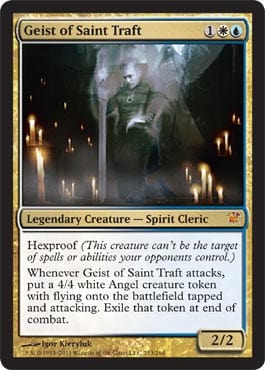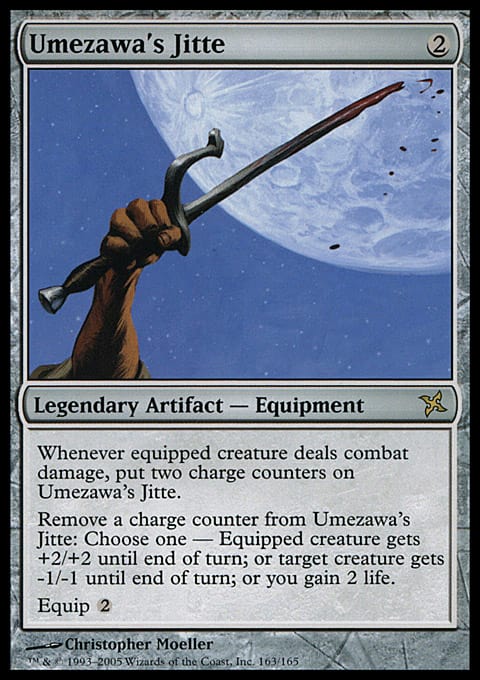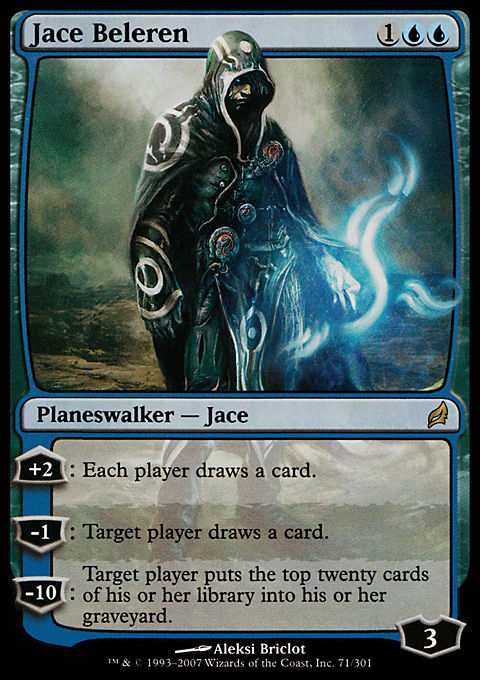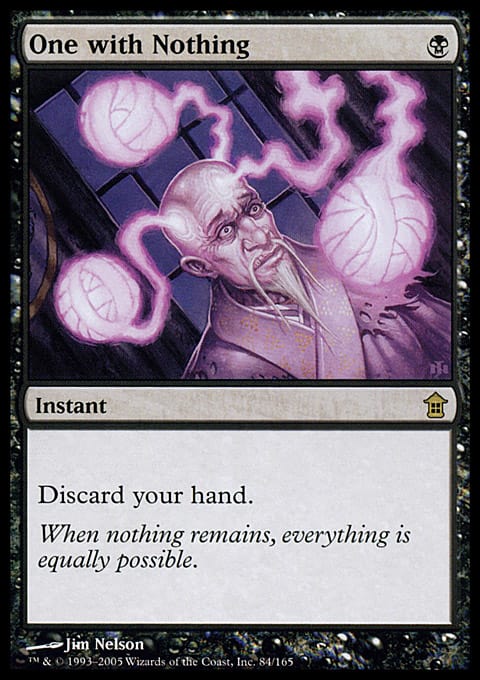Like most of you, I was caught a bit off guard by the recent rules changes. I’m sure everyone and their brother has opinion about them, but this is my soapbox, so here we are. If you have no idea what I’m talking about, you should read Matt Tabak’s and Sam Stoddard’s articles on the mothership. Overall, I like all of the changes, and I think they make sense perfectly. I’m going to address each of the new rules and give my thoughts on how they will affect competitive play.
The Legend Rule
Because I’m ancient, I actually remember what the original legend rules looked like. If a legendary creature (there weren’t any other legendary permanents yet) was on the battlefield, no other player could cast that card. Can you imagine playing a Geist of Saint Traft mirror match and literally not being able to cast your card if your opponent played his first?
When the set Legends came out, everyone I knew who played Magic had an informal rule: You could only have one of any specific legend in your deck. It’s not as though we all had play sets of every card back then—chances were that there was only one Dakkon Blackblade per group of players, so having more than one of the same legend in play simply never came up. I quit Magic around the time Visions came out and didn’t pick it up again until just before Mirrodin, so I missed out on the poster-child example of why a new legend rule was needed—namely Lin Sivvi, Defiant Hero. Every time I talk to someone who played competitively when Rebels was the deck to play, it’s as though I’m talking to a Vietnam War vet. Correct me if I’m wrong, but Lin Sivvi was the first example of a legend that was both cheap and very good in Constructed. Rebel mirrors were miserable to play, and the person going first was heavily favored to win. I’d be willing to bet that Lin Sivvi was single-handedly responsible for Wizards not wanting to print any good legends that cost less than 6 mana.
Fast-forward a few years, and the upcoming block had a heavy legendary theme. If Kamigawa was to succeed, something had to be done about the legend rule. Kamigawa was much maligned for many other reasons, but updating the legend rule was one thing it did right, and it’s what we’ve been using since. I don’t think anyone can argue that the rules we have today are vastly superior to the original ones. For one, you could no longer ever be locked out of playing your cards because your opponent happened to play his legend first. It had some interesting side effects, however, most of which we take for granted today. Every legend was now a removal spell for itself. This was never more evident than when decks with zero creatures played four copies of Umezawa's Jitte strictly to destroy their opponents’ Equipment. Clones suddenly became insane, as they could now be played as evoked Shriekmaws. Again, this is something we all take for granted now, but if you think about it, does it really make any sense?
The new rule may seem strange to those of us used to playing with the Kamigawa-era legend rule for so long, and I admit it will feel a little odd at first when my opponent and I have the same legendary creature in play. But you really need to ask yourself if you’re just clinging on to the old rules because they’re familiar. I’ve heard complaints like, “Oh, Geist of Saint Traft is harder to kill now.” Really? I mean, that’s technically not wrong, but if you’re playing a Geist mirror, using your Geist as a removal spell is hardly optimal. As Gerry Thompson said, having two Geists staring each other down is “no more awkward than Reckoner on Reckoner or Aristocrat vs. Aristocrat or Thundermaw vs. Thundermaw . . . instead of focusing on how [to answer a legend] you should be thinking about how to design your decks to be more proactive.” I couldn’t agree more with this sentiment. Again, this will seem weird at first, but everyone will quickly become used to it.
The Planeswalker Rule
The changes here are very similar to the legend-rule changes, so I won’t rehash what I’ve already said. The key difference here is there are multiple versions of the same planeswalker that have the same type. For example, Jace Beleren, Jace, the Mind Sculptor, and Jace, Architect of Thought are all of the same type. There was a time not too long ago when Jace Beleren was used as a preemptive removal spell for Jace, the Mind Sculptor. I don’t necessarily think that was a bad thing, and I still hold that Caw-Blade mirrors were some of the most skill-intensive matches I’ve ever played. The new rules, of course, drastically change the dynamics of how matches are played when the two players share planeswalker types. They remove a key strategic decision of what ability to use on your planeswalker. For example, say I’m playing an Esper control mirror. I have the opportunity to resolve a Jace, Architect of Thought. I can go for the −2 ability, but then I leave myself open to an end-of-turn Snapcaster Mage. If I opt for the +1 ability to protect him from such shenanigans, my opponent can play his Jace, and I’ve gained nothing.
The loss of decisions like these isn’t trivial, but the new rules also provide a lot of new interactions, and I think it’s a net gain. Yes, the obvious gain is that extra planeswalkers you draw are no longer dead cards, but I don’t think that makes a huge difference. If you’re casting a spell just to Cloudshift your planeswalker, that’s hardly game-breaking. There are a few of them for which it’s nice to have the option, though. I’m mostly thinking of planeswalkers that can’t “kill themselves” the turn after you play them—Domri Rade, Liliana of the Veil, Sorin, Lord of Innistrad, and Vraska the Unseen for instance. It may not come up all that often, but I can definitely envision some situations in which you want to use the minus ability as early and often as possible. The new rules allow you to do that at the cost of a card.
One interaction I think is neat is “going up the chain” with different planewalkers of the same type. It reminds me of the old Vs. System game. If I played a 3-drop Wolverine and later played the 7-drop version, it would replace the old one. You can really use that to your advantage with planeswalkers in Magic. Say you have a Garruk Relentless in play against your opponent’s Thragtusk. You can either sit there chump-blocking with your 2/2 Wolf all day or you can use the fight ability and have your opponent be up a 3/3 Beast in the exchange. Neither of these choices is particularly exciting, but now you have the option of upgrading your Garruk Relentless to Garruk, Primal Hunter, and you’re in a much better position. Having options like this opens up a lot of space for deck design, as you’re far less bottlenecked by the number of planeswalkers you can have. It also allows Wizards to print more of them. I wouldn’t be surprised if Standard in the near future has multiple versions of each planeswalker.
Everything Else
All of the other rules updates are far less mind-blowing (mind-sculpting?), so I’m only going to discuss them briefly here. The new sideboarding rule makes sense. I have a funny story about how I played One with Nothing in Constructed once. There was a Kamigawa-block Constructed Pro Tour Qualifier once upon a time, and I couldn’t find a copy of one of my sideboard cards. I can’t remember what card it was supposed to be, but not having it wasn’t that big a deal, and I didn’t have time to find an appropriate replacement. I was honestly just going to turn the random common I wrote on over and use that, but one of my friends insisted that I play One with Nothing instead. Later on in that tournament, I was eliminated by a Gaze of Adamaro, and it would have been correct to cast it.
Would the integrity of the tournament really been at stake if I just played a fourteen-card sideboard? If I can just play any random cards to fill my sideboard up to fifteen, the rule serves no purpose. It also removes the tremendous temptation to “fail to notice” when you accidentally sideboard in too many cards. All in all, the new sideboard rule seems perfectly sensible.
Making indestructible a keyword only matters in certain corner cases, and cleaning up the rules for playing additional lands makes things a lot less confusing.
Feel free to leave me a comment with your thoughts on the changes. Take care, and good luck to those of you playing in World Magic Cup Qualifiers this weekend.
Nassim Ketita
arcticninja on Magic Online




























